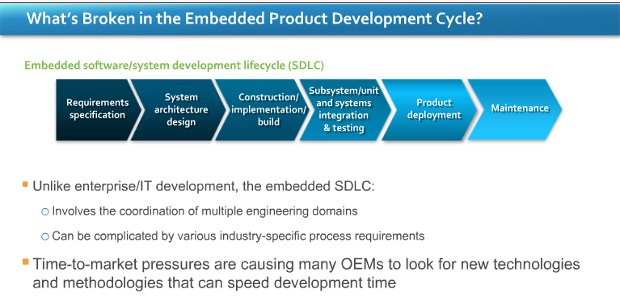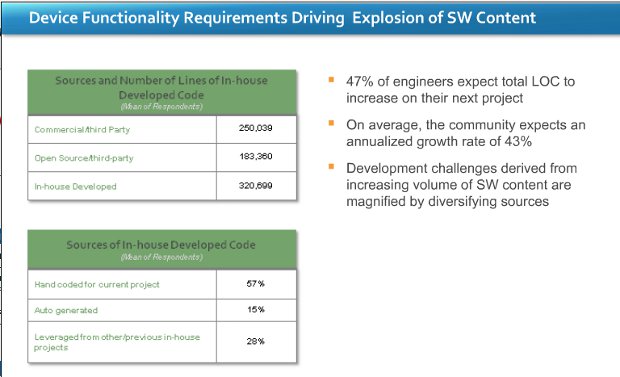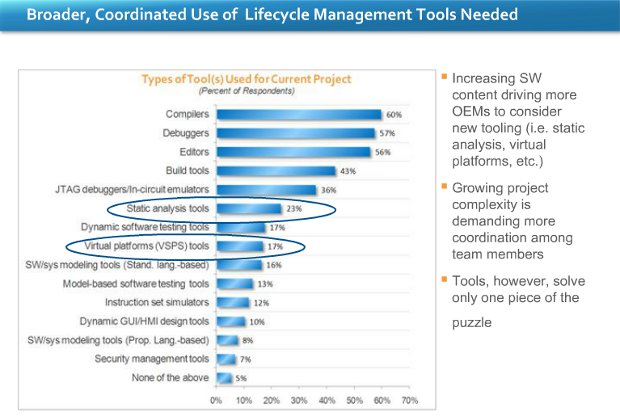I’ve recently attended a webinar entitled “Accelerate Your Next Embedded Development Project: Essential Tools and Techniques for Every Phase of Your Project Lifecycle” presented by Wind river and VDC Research.
The two speakers were:
- Marc Brown, Wind River VP, Tools and Marketing Operation.
- Christopher Rommel, Senior Analyst at VDC Research.
The webinar was composed of three sections:
- Industry Challenges. (Wind River)
- Embedded Development: Data and Trends. (VDC Research)
- New ways to accelerate development (Wind River)
Industry challenges
Marc describes the new challenges for device software drivers:
- Increased security, safety and quality requirements for connectivity
- Performance scalability: multi-cores, many cores and SoC support.
- Pressure to lower OPEX (Operating Expenses)
Companies are now pushed to increase performance, become more cost effective and provide a better connectivity while at the same time decrease time to market, project risks and security issues.
Data and Trends
Christopher first present a slide showing there are still many embedded projects that are late mainl because of:
- Changes in specs
- Complexity of applications
- Customer changes requirements during project
- Technical obstacles.
He also explains that many projects will move to multicore and in 2011, only 15% of engineers and managers expect their future projects (in 2 years) to use single core processors.
He then says that software development cycle for Embedded systems is more complex than enterprise/IT development because it involves multiple engineering domains and various industry-specific requirements.

The number of line of codes is also exploding, with many embedded software using more than 1 millions lines of code. Many engineers expect massive growth in total LOC and that drives complexity even further.

So tools are needed to improve quality and time to market of embedded software. As you can see in the chart below, although most engineering use compiler, debugger and editors, relatively few use tools such as virtualization platform and static analysis tools.

VDC Research recommends to use the following tools to abstract the complexity of embedded systems:
- Test Automation Tools
- Static Analysis Tools
- Virtual System Prototyping/Simulation (VSPS) tools
However, tools are only part of the puzzle and engineering process must also be changed to decrease time to market and improve software quality.
New ways to accelerate development (Wind River solutions)
In this final section, Marc describes five Wind River’s tools and services:
- Simics: Full-system simulator used to run unchanged production binaries of the target hardware at high-performance speeds.
- Workbench: Collection of tools aiming at accelerating time-to-market for developers building devices with VxWorks and Wind River Linux.
- Test management: Test management solution that identifies high-risk segments in production code, enabling change-based, optimized testing, using real-time instrumentation of devices under test.
- Diab Compiler: Wind River Diab Compiler.
- Professional Services
and 5 developments stages:
- Define: Document and analyze system architecture.
- Bring up: Boot, configure and stabilize hardware and OS.
- Develop: Build the application.
- Integrate: Assemble and test systems components.
- Sustain: Keep deployed devices running at optimal performance.
He then explains which Wind River tools and/or service can be used in each of the five development phases:
- Define: Simics (to run simulation before the hardware is available) and Wind River’s professional services.
- Bring up: Simics (drivers development in simulator), Workbench On-chip debugging and Test management
- Develop: Simics (in case there are not enough boards for development and sometimes it is faster to develop in the simulator), Diab compiler and Workbench.
- Integrate: Workbench On-Chip debugger, Workbench, Test Management and Simics.
- Sustain: Simics (for debugging without real hardware) and Professional services.
The final part is the Q&A session. The webinar is now available on-demand at http://ecast.opensystemsmedia.com/297

Jean-Luc started CNX Software in 2010 as a part-time endeavor, before quitting his job as a software engineering manager, and starting to write daily news, and reviews full time later in 2011.
Support CNX Software! Donate via cryptocurrencies, become a Patron on Patreon, or purchase goods on Amazon or Aliexpress




